[English] 日本語
 Yorodumi
Yorodumi- PDB-1mox: Crystal Structure of Human Epidermal Growth Factor Receptor (resi... -
+ Open data
Open data
- Basic information
Basic information
| Entry | Database: PDB / ID: 1mox | |||||||||
|---|---|---|---|---|---|---|---|---|---|---|
| Title | Crystal Structure of Human Epidermal Growth Factor Receptor (residues 1-501) in complex with TGF-alpha | |||||||||
 Components Components |
| |||||||||
 Keywords Keywords | transferase/growth factor / EGFR / Receptor /  Complex / Complex /  Growth Factor / transferase-growth factor COMPLEX Growth Factor / transferase-growth factor COMPLEX | |||||||||
| Function / homology |  Function and homology information Function and homology informationhepatocyte proliferation / Cargo concentration in the ER / response to hydroxyisoflavone /  multivesicular body, internal vesicle lumen / positive regulation of prolactin secretion / negative regulation of cardiocyte differentiation / positive regulation of protein kinase C activity / diterpenoid metabolic process / Shc-EGFR complex / multivesicular body, internal vesicle lumen / positive regulation of prolactin secretion / negative regulation of cardiocyte differentiation / positive regulation of protein kinase C activity / diterpenoid metabolic process / Shc-EGFR complex /  ovulation cycle ...hepatocyte proliferation / Cargo concentration in the ER / response to hydroxyisoflavone / ovulation cycle ...hepatocyte proliferation / Cargo concentration in the ER / response to hydroxyisoflavone /  multivesicular body, internal vesicle lumen / positive regulation of prolactin secretion / negative regulation of cardiocyte differentiation / positive regulation of protein kinase C activity / diterpenoid metabolic process / Shc-EGFR complex / multivesicular body, internal vesicle lumen / positive regulation of prolactin secretion / negative regulation of cardiocyte differentiation / positive regulation of protein kinase C activity / diterpenoid metabolic process / Shc-EGFR complex /  ovulation cycle / Inhibition of Signaling by Overexpressed EGFR / ovulation cycle / Inhibition of Signaling by Overexpressed EGFR /  epidermal growth factor receptor activity / COPII-mediated vesicle transport / EGFR interacts with phospholipase C-gamma / positive regulation of mucus secretion / response to UV-A / epidermal growth factor receptor activity / COPII-mediated vesicle transport / EGFR interacts with phospholipase C-gamma / positive regulation of mucus secretion / response to UV-A /  epidermal growth factor binding / PLCG1 events in ERBB2 signaling / tongue development / midgut development / ERBB2-EGFR signaling pathway / hydrogen peroxide metabolic process / PTK6 promotes HIF1A stabilization / digestive tract morphogenesis / epidermal growth factor binding / PLCG1 events in ERBB2 signaling / tongue development / midgut development / ERBB2-EGFR signaling pathway / hydrogen peroxide metabolic process / PTK6 promotes HIF1A stabilization / digestive tract morphogenesis /  regulation of nitric-oxide synthase activity / regulation of nitric-oxide synthase activity /  epidermal growth factor receptor binding / ERBB2 Activates PTK6 Signaling / morphogenesis of an epithelial fold / intracellular vesicle / Signaling by EGFR / response to cobalamin / negative regulation of epidermal growth factor receptor signaling pathway / epidermal growth factor receptor binding / ERBB2 Activates PTK6 Signaling / morphogenesis of an epithelial fold / intracellular vesicle / Signaling by EGFR / response to cobalamin / negative regulation of epidermal growth factor receptor signaling pathway /  transmembrane receptor protein tyrosine kinase activator activity / protein tyrosine kinase activator activity / Signaling by ERBB4 / regulation of phosphatidylinositol 3-kinase/protein kinase B signal transduction / protein insertion into membrane / eyelid development in camera-type eye / cerebral cortex cell migration / ERBB2 Regulates Cell Motility / regulation of JNK cascade / positive regulation of cell division / activation of phospholipase C activity / positive regulation of cyclin-dependent protein serine/threonine kinase activity / PI3K events in ERBB2 signaling / negative regulation of mitotic cell cycle / hair follicle development / transmembrane receptor protein tyrosine kinase activator activity / protein tyrosine kinase activator activity / Signaling by ERBB4 / regulation of phosphatidylinositol 3-kinase/protein kinase B signal transduction / protein insertion into membrane / eyelid development in camera-type eye / cerebral cortex cell migration / ERBB2 Regulates Cell Motility / regulation of JNK cascade / positive regulation of cell division / activation of phospholipase C activity / positive regulation of cyclin-dependent protein serine/threonine kinase activity / PI3K events in ERBB2 signaling / negative regulation of mitotic cell cycle / hair follicle development /  MAP kinase kinase kinase activity / Estrogen-dependent nuclear events downstream of ESR-membrane signaling / positive regulation of G1/S transition of mitotic cell cycle / embryonic placenta development / mammary gland alveolus development / positive regulation of bone resorption / GAB1 signalosome / positive regulation of nitric oxide mediated signal transduction / salivary gland morphogenesis / regulation of peptidyl-tyrosine phosphorylation / peptidyl-tyrosine autophosphorylation / positive regulation of glial cell proliferation / positive regulation of phosphorylation / positive regulation of vasoconstriction / Signaling by ERBB2 / cellular response to epidermal growth factor stimulus / cellular response to cadmium ion / positive regulation of DNA repair / GRB2 events in EGFR signaling / SHC1 events in EGFR signaling / EGFR Transactivation by Gastrin / TFAP2 (AP-2) family regulates transcription of growth factors and their receptors / GRB2 events in ERBB2 signaling / endoplasmic reticulum-Golgi intermediate compartment membrane / MAP kinase kinase kinase activity / Estrogen-dependent nuclear events downstream of ESR-membrane signaling / positive regulation of G1/S transition of mitotic cell cycle / embryonic placenta development / mammary gland alveolus development / positive regulation of bone resorption / GAB1 signalosome / positive regulation of nitric oxide mediated signal transduction / salivary gland morphogenesis / regulation of peptidyl-tyrosine phosphorylation / peptidyl-tyrosine autophosphorylation / positive regulation of glial cell proliferation / positive regulation of phosphorylation / positive regulation of vasoconstriction / Signaling by ERBB2 / cellular response to epidermal growth factor stimulus / cellular response to cadmium ion / positive regulation of DNA repair / GRB2 events in EGFR signaling / SHC1 events in EGFR signaling / EGFR Transactivation by Gastrin / TFAP2 (AP-2) family regulates transcription of growth factors and their receptors / GRB2 events in ERBB2 signaling / endoplasmic reticulum-Golgi intermediate compartment membrane /  transmembrane receptor protein tyrosine kinase activity / transmembrane receptor protein tyrosine kinase activity /  neurogenesis / cellular response to dexamethasone stimulus / SHC1 events in ERBB2 signaling / neurogenesis / cellular response to dexamethasone stimulus / SHC1 events in ERBB2 signaling /  ossification / positive regulation of synaptic transmission, glutamatergic / basal plasma membrane / regulation of ERK1 and ERK2 cascade / positive regulation of mitotic nuclear division / neuron projection morphogenesis / positive regulation of superoxide anion generation / positive regulation of DNA replication / Signal transduction by L1 / epithelial cell proliferation / cellular response to estradiol stimulus / ossification / positive regulation of synaptic transmission, glutamatergic / basal plasma membrane / regulation of ERK1 and ERK2 cascade / positive regulation of mitotic nuclear division / neuron projection morphogenesis / positive regulation of superoxide anion generation / positive regulation of DNA replication / Signal transduction by L1 / epithelial cell proliferation / cellular response to estradiol stimulus /  liver regeneration / positive regulation of epithelial cell proliferation / NOTCH3 Activation and Transmission of Signal to the Nucleus / astrocyte activation / cellular response to amino acid stimulus / positive regulation of protein localization to plasma membrane / EGFR downregulation / clathrin-coated endocytic vesicle membrane / positive regulation of smooth muscle cell proliferation / lung development / Signaling by ERBB2 TMD/JMD mutants / liver regeneration / positive regulation of epithelial cell proliferation / NOTCH3 Activation and Transmission of Signal to the Nucleus / astrocyte activation / cellular response to amino acid stimulus / positive regulation of protein localization to plasma membrane / EGFR downregulation / clathrin-coated endocytic vesicle membrane / positive regulation of smooth muscle cell proliferation / lung development / Signaling by ERBB2 TMD/JMD mutants /  growth factor activity / Constitutive Signaling by EGFRvIII / positive regulation of MAP kinase activity growth factor activity / Constitutive Signaling by EGFRvIII / positive regulation of MAP kinase activitySimilarity search - Function | |||||||||
| Biological species |   Homo sapiens (human) Homo sapiens (human) | |||||||||
| Method |  X-RAY DIFFRACTION / X-RAY DIFFRACTION /  MIR / Resolution: 2.5 Å MIR / Resolution: 2.5 Å | |||||||||
 Authors Authors | Garrett, T.P.J. / McKern, N.M. / Lou, M. / Elleman, T.C. / Adams, T.E. / Lovrecz, G.O. / Zhu, H.-J. / Walker, F. / Frenkel, M.J. / Hoyne, P.A. ...Garrett, T.P.J. / McKern, N.M. / Lou, M. / Elleman, T.C. / Adams, T.E. / Lovrecz, G.O. / Zhu, H.-J. / Walker, F. / Frenkel, M.J. / Hoyne, P.A. / Jorissen, R.N. / Nice, E.C. / Burgess, A.W. / Ward, C.W. | |||||||||
 Citation Citation |  Journal: Cell(Cambridge,Mass.) / Year: 2002 Journal: Cell(Cambridge,Mass.) / Year: 2002Title: Crystal Structure of a Truncated Epidermal Growth Factor Receptor Extracellular Domain Bound to Transforming Growth Factor alpha Authors: Garrett, T.P.J. / McKern, N.M. / Lou, M. / Elleman, T.C. / Adams, T.E. / Lovrecz, G.O. / Zhu, H.-J. / Walker, F. / Frenkel, M.J. / Hoyne, P.A. / Jorissen, R.N. / Nice, E.C. / Burgess, A.W. / Ward, C.W. | |||||||||
| History |
|
- Structure visualization
Structure visualization
| Structure viewer | Molecule:  Molmil Molmil Jmol/JSmol Jmol/JSmol |
|---|
- Downloads & links
Downloads & links
- Download
Download
| PDBx/mmCIF format |  1mox.cif.gz 1mox.cif.gz | 224.3 KB | Display |  PDBx/mmCIF format PDBx/mmCIF format |
|---|---|---|---|---|
| PDB format |  pdb1mox.ent.gz pdb1mox.ent.gz | 182.8 KB | Display |  PDB format PDB format |
| PDBx/mmJSON format |  1mox.json.gz 1mox.json.gz | Tree view |  PDBx/mmJSON format PDBx/mmJSON format | |
| Others |  Other downloads Other downloads |
-Validation report
| Arichive directory |  https://data.pdbj.org/pub/pdb/validation_reports/mo/1mox https://data.pdbj.org/pub/pdb/validation_reports/mo/1mox ftp://data.pdbj.org/pub/pdb/validation_reports/mo/1mox ftp://data.pdbj.org/pub/pdb/validation_reports/mo/1mox | HTTPS FTP |
|---|
-Related structure data
| Related structure data | |
|---|---|
| Similar structure data |
- Links
Links
- Assembly
Assembly
| Deposited unit | 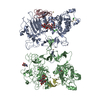
| ||||||||
|---|---|---|---|---|---|---|---|---|---|
| 1 |
| ||||||||
| Unit cell |
| ||||||||
| Details | The asymmetric unit contains the 2:2 complex as would appear in the functional dimer |
- Components
Components
-Protein / Protein/peptide , 2 types, 4 molecules ABCD
| #1: Protein |  Mass: 55693.328 Da / Num. of mol.: 2 / Fragment: Extracellular Fragment Source method: isolated from a genetically manipulated source Source: (gene. exp.)   Homo sapiens (human) / Gene: EGFR / Cell line (production host): Lec8 / Production host: Homo sapiens (human) / Gene: EGFR / Cell line (production host): Lec8 / Production host:   Cricetulus griseus (Chinese hamster) / References: UniProt: P00533, EC: 2.7.1.112 Cricetulus griseus (Chinese hamster) / References: UniProt: P00533, EC: 2.7.1.112#2: Protein/peptide | Mass: 5560.246 Da / Num. of mol.: 2 Source method: isolated from a genetically manipulated source Source: (gene. exp.)   Homo sapiens (human) / Gene: TGFA / Production host: Homo sapiens (human) / Gene: TGFA / Production host:   Escherichia coli (E. coli) / References: UniProt: P01135 Escherichia coli (E. coli) / References: UniProt: P01135 |
|---|
-Sugars , 5 types, 5 molecules 
| #3: Polysaccharide | 2-acetamido-2-deoxy-beta-D-glucopyranose-(1-4)-[alpha-L-fucopyranose-(1-6)]2-acetamido-2-deoxy-beta- ...2-acetamido-2-deoxy-beta-D-glucopyranose-(1-4)-[alpha-L-fucopyranose-(1-6)]2-acetamido-2-deoxy-beta-D-glucopyranose / Mass: 570.542 Da / Num. of mol.: 1 / Mass: 570.542 Da / Num. of mol.: 1Source method: isolated from a genetically manipulated source |
|---|---|
| #4: Polysaccharide | alpha-D-mannopyranose-(1-3)-beta-D-mannopyranose-(1-4)-2-acetamido-2-deoxy-beta-D-glucopyranose-(1- ...alpha-D-mannopyranose-(1-3)-beta-D-mannopyranose-(1-4)-2-acetamido-2-deoxy-beta-D-glucopyranose-(1-4)-2-acetamido-2-deoxy-beta-D-glucopyranose / Mass: 748.682 Da / Num. of mol.: 1 / Mass: 748.682 Da / Num. of mol.: 1Source method: isolated from a genetically manipulated source |
| #5: Polysaccharide | beta-D-mannopyranose-(1-4)-2-acetamido-2-deoxy-beta-D-glucopyranose-(1-4)-[alpha-L-fucopyranose-(1- ...beta-D-mannopyranose-(1-4)-2-acetamido-2-deoxy-beta-D-glucopyranose-(1-4)-[alpha-L-fucopyranose-(1-6)]2-acetamido-2-deoxy-beta-D-glucopyranose / Mass: 732.682 Da / Num. of mol.: 1 / Mass: 732.682 Da / Num. of mol.: 1Source method: isolated from a genetically manipulated source |
| #6: Polysaccharide | 2-acetamido-2-deoxy-beta-D-glucopyranose-(1-4)-2-acetamido-2-deoxy-beta-D-glucopyranose / Mass: 424.401 Da / Num. of mol.: 1 / Mass: 424.401 Da / Num. of mol.: 1Source method: isolated from a genetically manipulated source |
| #10: Sugar | ChemComp-NAG /  N-Acetylglucosamine N-Acetylglucosamine |
-Non-polymers , 4 types, 101 molecules 






| #7: Chemical | ChemComp-PT / #8: Chemical | ChemComp-CD / #9: Chemical | ChemComp-CL /  Chloride Chloride#11: Water | ChemComp-HOH / |  Water Water |
|---|
-Experimental details
-Experiment
| Experiment | Method:  X-RAY DIFFRACTION / Number of used crystals: 1 X-RAY DIFFRACTION / Number of used crystals: 1 |
|---|
- Sample preparation
Sample preparation
| Crystal | Density Matthews: 3.23 Å3/Da / Density % sol: 61.89 % | |||||||||||||||||||||||||||||||||||
|---|---|---|---|---|---|---|---|---|---|---|---|---|---|---|---|---|---|---|---|---|---|---|---|---|---|---|---|---|---|---|---|---|---|---|---|---|
Crystal grow | Temperature: 293 K / Method: vapor diffusion, hanging drop / pH: 7.5 Details: 7% PEG 3350, 20% Trehalose, 10mM CdCl2, 100mM HEPES, di-mu-iodobis(ethylenediamine)diplatinum nitrate, pH 7.5, VAPOR DIFFUSION, HANGING DROP, temperature 293K | |||||||||||||||||||||||||||||||||||
| Crystal grow | *PLUS Method: vapor diffusion | |||||||||||||||||||||||||||||||||||
| Components of the solutions | *PLUS
|
-Data collection
| Diffraction | Mean temperature: 103 K |
|---|---|
| Diffraction source | Source:  ROTATING ANODE / Type: RIGAKU RU300 / Wavelength: 1.5418 Å ROTATING ANODE / Type: RIGAKU RU300 / Wavelength: 1.5418 Å |
| Detector | Type: RIGAKU RAXIS IV / Detector: IMAGE PLATE / Details: AXCO capillary optics |
| Radiation | Monochromator: Ni filter / Protocol: SINGLE WAVELENGTH / Monochromatic (M) / Laue (L): M / Scattering type: x-ray |
| Radiation wavelength | Wavelength : 1.5418 Å / Relative weight: 1 : 1.5418 Å / Relative weight: 1 |
| Reflection | Resolution: 2.5→30 Å / Num. all: 48326 / % possible obs: 90 % / Redundancy: 3.17 % / Rmerge(I) obs: 0.075 / Net I/σ(I): 10.8 |
| Reflection | *PLUS % possible obs: 90.2 % |
- Processing
Processing
| Software |
| ||||||||||||||||||||
|---|---|---|---|---|---|---|---|---|---|---|---|---|---|---|---|---|---|---|---|---|---|
| Refinement | Method to determine structure : :  MIR / Resolution: 2.5→20 Å / Cross valid method: THROUGHOUT / σ(F): 0 / Stereochemistry target values: Engh & Huber MIR / Resolution: 2.5→20 Å / Cross valid method: THROUGHOUT / σ(F): 0 / Stereochemistry target values: Engh & Huber
| ||||||||||||||||||||
| Displacement parameters |
| ||||||||||||||||||||
| Refinement step | Cycle: LAST / Resolution: 2.5→20 Å
| ||||||||||||||||||||
| Refine LS restraints |
| ||||||||||||||||||||
| Refinement | *PLUS | ||||||||||||||||||||
| Solvent computation | *PLUS | ||||||||||||||||||||
| Displacement parameters | *PLUS |
 Movie
Movie Controller
Controller






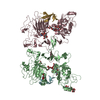
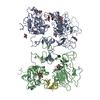
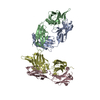
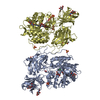
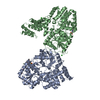


 PDBj
PDBj


















